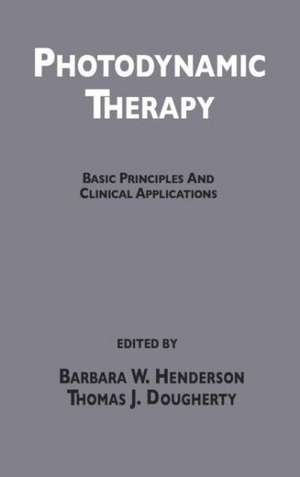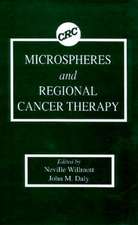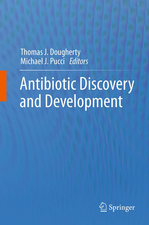Photodynamic Therapy: Basic Principles and Clinical Applications
Autor Barbara W. Hendersonen Limba Engleză Hardback – 19 iun 1992
Preț: 2876.87 lei
Preț vechi: 3028.28 lei
-5% Nou
Puncte Express: 4315
Preț estimativ în valută:
550.56€ • 572.67$ • 454.52£
550.56€ • 572.67$ • 454.52£
Carte tipărită la comandă
Livrare economică 14-28 aprilie
Preluare comenzi: 021 569.72.76
Specificații
ISBN-13: 9780824786809
ISBN-10: 0824786807
Pagini: 480
Dimensiuni: 156 x 234 x 28 mm
Greutate: 0.82 kg
Ediția:1
Editura: CRC Press
Colecția CRC Press
ISBN-10: 0824786807
Pagini: 480
Dimensiuni: 156 x 234 x 28 mm
Greutate: 0.82 kg
Ediția:1
Editura: CRC Press
Colecția CRC Press
Public țintă
ProfessionalCuprins
Historical perspective, Thomas J. Dougherty, et al. Part 1 Molecular and cellular effects of photodynamic therapy: fluorescence and photodynamic effects of phthalocyanines and porphyrins in cells, Johan Moan, et al; photodynamic therapy - membrane and enzyme photobiology, Tom M.A.R. Dubbleman, et al; cellular targets of photodynamic therapy as a guide to mechanisms, Russell Hilf; cellular stress responses following photodynamic therapy, Stefan W. Ryter, et al; basic photobiology and mechanisms of action of phthalocyanines, Ehud Ben-Hur; cationic sensitizers, combination therapies, and new methodologies, Allan R. Oseroff; bacterial and viral photodynamic inactivation, Zvi Malik, et al. Part 2 Tissue effects of photodynamic therapy: determinants for photodynamic tissue destruction, David A. Bellnier and Barbara W. Henderson; photosensitizing dyes related to hematoporphyrin derivative - structure-activity relationships, David Kessel, et al; phthalocyanines and related compounds - structure activity relationships, Benoit Paquette and Johan E. van Lier; reduced porphyrins as photosensitizers - synthesis and biological effects, Alan R. Morgan; low density lipoproteins-liposome delivery systems for tumour photosensitizers in vivo, Giulio Jori; photosensitizer delivery mediated by macro-molecular carrier systems, Tayyaba Hasan; normal tissue damage following photodynamic therapy - are there biological advantages?, Hugh Barr and Stephen G. Bown. Part 3 Clinical applications of photodynamic therapy: clinical photodynamic therapy - the continuing evolution, Stuart L. Marcus; photodynamic therapy in treatment of early cancer, Yoshihiro Hayata and Harubumi Kato; palliation for endobronchial tumours in lung cancer, Anne-Marie Regal; innovative photodynamic therapy at the National Cancer Institute - intraoperative, intracavitary treatment, Harvey I. Pass and Thomas F. DeLaney; clinical application of photodynamic therapy - German collaborative studies, Kieter Jocham, et al; photodynamic therapy - an eight-year experience, James S. McCaughan, et al. Part 4 Photophysics and photodynamic therapy technology: light delivery and optical dosimetry in photodynamic therapy of solid tumours, Willem M. Star, et al; the implications of photobleaching for photodynamic therapy, Lars O. Svaasand and William R. Potter; laser spectroscopy in medical diagnostics, Stefan Andersson-Engels, et al.
Descriere
Covering all aspects of photodynamic therapy, 70 expert contributors from the fields of photochemistry, photobiology, photophysics, pharmacology, oncology and surgery, provide multidisciplinary discussions on photodynamic therapy - a rapidly-developing approach to the treatment of solid tumours.;Photodynamic Therapy: Basic Principles and Clinical Applications describes the molecular and cellular effects of photodynamic treatment; elucidates the complex events leading to photodynamics tissue destruction, particularly vascular and inflammatory responses; discusses the principles of light penetration through tissues and optical dosimetry; examines photosensitizer pharmacology and delivery systems; reviews in detail photosensitizer structure-activity relationships; illustrates novel devices that aid light dosimetry and fluorescence detection; and extensively delineates clinical applications, including early diagnosis and treatment.;A comprehensive and up-to-date reference, this book should be useful for oncologists, pharmacologists, surgeons, photobiologists, optical engineers, laser technicians, biologists, physicists, chemists and biochemists involved in cancer research, as well as graduate-level students in these disciplines.














